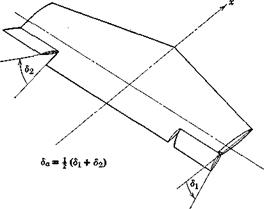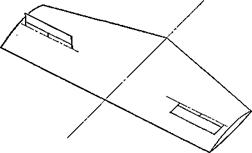ROLLING CONTROL
The angle of bank of the airplane is controlled by the ailerons. The primary function of these controls is to produce a rolling moment, although they frequently introduce a yawing moment as well. The effectiveness of the ailerons in producing rolling and yawing moments is described by the two control derivatives dCljdba and dCJdda. The aileron angle 6a is defined as the mean value of the angular displacements of the two ailerons. It is positive when the right aileron movement is downward (see Fig. 8.5). The derivative dCJdda is normally negative, right aileron down producing a roll to the left.
For simple flap-type ailerons, the increase in lift on the right side and the decrease on the left side produce a drag differential which gives a positive (nose-right) yawing moment. Since the normal reason for moving the right aileron down is to initiate a turn to the left, then the yawing moment is seen to be in just the wrong direction. It is therefore called aileron adverse yaw. On high-aspect-ratio airplanes this tendency may introduce decided difficulties in lateral control. Means for avoiding this particular difficulty include the use of spoilers and Frise ailerons. Spoilers are illustrated in Fig. 8.6. They achieve the desired result by reducing the lift and increasing the drag on the side where the spoiler is raised. Thus the rolling and yawing moments
|
Fig. 8.5 Aileron angle. |
developed are mutually complementary with respect to turning. Frise ailerons (Fig. 6.23) diminish the adverse yaw or eliminate it entirely by increasing the drag on the side of the upgoing aileron. This is achieved by the shaping of the aileron nose and the choice of hinge location. When deflected upward, the gap between the control surface and the wing is increased, and the relatively sharp nose protrudes into the stream. Both these geometrical factors produce a drag increase.
|
|
|
Section through spoiler |
The deflection of the ailerons leads to still additional yawing moments once the airplane acquires a roll rate. These are caused by the altered flow about the wing and tail. These effects are discussed in Sec. 8.6 (Gn ), and are illustrated in Figs. 8.12 and 8.15.
A final remark about aileron controls is in order. They are functionally distinct from the other two controls in that they are rate controls. If the airplane is restricted only to rotation about the wind axis, then the application of a constant aileron angle results in a steady rate of roll. The elevator and rudder, on the other hand, are displacement controls. When the airplane is constrained to the relevant single-axis degree of freedom, a constant deflection of these controls produces a constant angular displacement of the airplane. It appears that both rate and displacement controls are acceptable to pilots.













